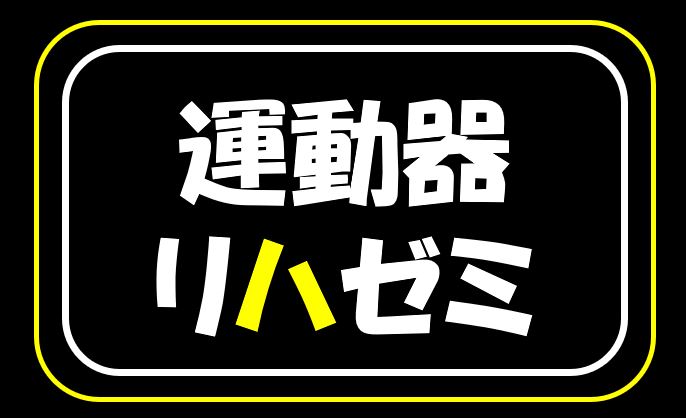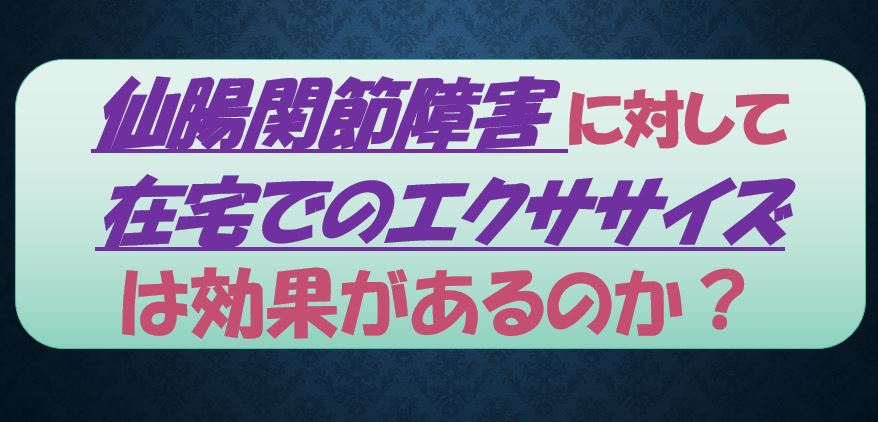こんにちは!
運動器専門のリハビリスタッフです!!
いつもお世話になります。
今回は、『仙腸関節障害に対して在宅でのエクササイズは効果があるのか?』
について解説させていただきます。
仙腸関節は仙骨と腸骨で構成される関節です。
仙腸関節障害は非特異的腰痛(画像が難しい腰痛)であり、急性腰痛症(いわゆるぎっくり腰)の原因の一つであるとされています。
また慢性腰痛症の要因のひとつでもあります。
仙腸関節障害は、1905年にGoldthwaitが提唱しており、外傷や感染症などによる明らかな関節破壊を伴わない仙腸関節由来の痛みとしております。
また、MRやCT画像での仙腸関節の機能障害を示す特異的な所見を捉えることは困難(Bernard TN Jr.1991)と報告されています。
腰痛に占める仙腸関節性腰痛の頻度は3.5~30%との報告があるが、村上の1年間調査では504例中54例(10.7%)であった(村上.2010)とされています。
そんな中、2021年に、仙腸関節障害に対して徒手療法および在宅での仙腸関節・腰部エクササイズの有効性について検証した論文が海外で報告されております。
この論文の検証結果が気になるところです。
◆論文紹介
Randomized Controlled Trial
. 2021 May;24(3):223-233.
The Efficiency of Manual Therapy and Sacroiliac and Lumbar Exercises in Patients with Sacroiliac Joint Dysfunction Syndrome
仙腸関節機能不全症候群患者における徒手療法と仙腸関節・腰部エクササイズの効率性について
Aghalar Javadov 1, Aysegül Ketenci 2, Cihan Aksoy 2
Affiliations expand
- PMID: 33988941
Free article
Abstract
Background: Manual therapy, exercise therapy, and the combination of these 2 are common treatments for sacroiliac joint dysfunction syndrome. The effects of these treatments have been discussed in several studies; the superiority of one over the other for patients with sacroiliac joint dysfunction syndrome is still the subject of discussion.
概要
背景 仙腸関節機能不全症候群に対する治療法として、徒手療法、運動療法、およびこれらの併用療法が一般的である。これらの治療法の効果についてはいくつかの研究で議論されているが,仙腸関節機能不全症候群の患者に対する1つの治療法の優劣についてはまだ議論のあるところである.
Objective: This study aims to assess the effects of manual therapy for sacroiliac joints, sacroiliac joints home-based exercises, and home-based lumbar exercises.
目的 本研究では、仙腸関節に対する手技療法、仙腸関節の在宅エクササイズ、腰椎の在宅エクササイズの効果を評価することを目的とする。
Study design: A comparative, prospective, single-blind, randomized, controlled trial.
研究デザイン 比較、前向き、単盲検、無作為化、対照試験。
Setting: This trial was conducted at a single center at the Istanbul University, Istanbul Medical Faculty, Department of Physical Medicine and Rehabilitation.
設定。この試験は、Istanbul University, Istanbul Medical Faculty, Department of Physical Medicine and Rehabilitationの単一センターで実施された。
Methods: Within the scope of this study, 69 women diagnosed with sacroiliac joint dysfunction syndrome through specific sacroiliac joints clinical diagnostic tests were randomized into 3 groups. The first group was assigned manual therapy and a sacroiliac joints home-based exercise program (n = 23), the second group was assigned sacroiliac joints manual therapy and a home-based lumbar exercise program (n = 23), and the third group was assigned a home-based lumbar exercise program (n = 23). All patients who participated in the study were evaluated at the beginning of the study and on the twenty-eighth and ninetieth day.
方法 この研究の範囲内で、特定の仙腸関節臨床診断テストにより仙腸関節機能不全症候群と診断された女性69名を3群に無作為に割り付けた。第1グループは徒手療法と仙腸関節の在宅運動プログラム(n=23)、第2グループは仙腸関節の徒手療法と腰部の在宅運動プログラム(n=23)、第3グループは腰部の在宅運動プログラム(n=23)であった。研究に参加したすべての患者は、研究開始時、28日目、90日目に評価を受けた。
Results: All 3 groups showed a significant decrease in the sacroiliac joints -related pain parameter, which is checked with the visual analogue scale (P < 0.05) after the treatment. The Gillet test, Vorlauf test, Posterior Shear test, Compression test, and irritation Point tests after the treatment yielded a significant (P < 0.05) negative trend in all groups. Short Form-36 health survey for screening form, Modified Oswestry Pain Questionnaire, and Douleur Neuropathique 4 questions patient interview questionnaire for the assessment of neuropathic pain forms revealed a significant (P < 0.05) improvement in patients’ complaints after the treatment in all 3 groups. Significant improvement in patients with sacroiliac joint dysfunction syndrome in all 3 groups was identified after the treatment.
結果 3群とも治療後,Visual Analogue Scaleで確認する仙腸関節関連痛のパラメータが有意に減少した(P < 0.05).治療後のGilletテスト、Vorlaufテスト、Posterior Shearテスト、Compressionテスト、irritation Pointテストでは、全群で有意な(P < 0.05)陰性化傾向を示した。Short Form-36 health survey for screening form、Modified Oswestry Pain Questionnaire、Douleur Neuropathique 4 questions patient interview questionnaire for the assessment of neuropathic pain formsでは、3群とも治療後に患者の訴えに有意な(P < 0.05)改善がみられた。また、仙腸関節機能不全症候群の患者に対しては、3群すべてにおいて治療後に有意な改善が確認された。
Limitation: The absence of a healthy control group is one of the important limitations of the study.
限界 健康な対照群がないことは、この研究の重要な限界の一つである。
◆論文の結論
Conclusions: Manual therapy is effective in the long term in sacroiliac joint dysfunction syndrome. Adding specific exercises for sacroiliac joints to the sacroiliac joints manipulation treatment further increases this effectiveness.
結論 徒手療法は仙腸関節機能不全症候群に長期的に有効である。仙腸関節のマニピュレーション治療に仙腸関節に特化したエクササイズを加えることで、この効果はさらに高まります。
◆まとめ
上記論文では仙腸関節機能不全症候群と診断された女性69名を3群に振り分け、徒手療法および仙腸関節・腰部の在宅エクササイズの効果について検証しております。
第1グループ:徒手療法と腰部の在宅エクササイズ
第2グループ:徒手療法と腰部の在宅エクササイズ
第3グループ:腰部の在宅エクササイズ
介入開始時、介入後28日目、介入後90日目に
・Visual Analogue Scale(疼痛)
・Gilletテスト(骨盤アライメント)
・Vorlaufテスト(骨盤アライメント)
・Posterior Shearテスト(後方剪断)
・Compressionテスト(圧迫)
・irritation Pointテスト(刺激点)
・Short Form-36 health survey for screening form(SF36:健康状態調査)
・Modified Oswestry Pain Questionnaire(疼痛評価)
・Douleur Neuropathique 4 questions patient interview questionnaire for the assessment of neuropathic pain forms(DN4:神経障害テスト)
これらを評価しております。
結果 3群とも治療後,Visual Analogue Scale(疼痛)で仙腸関節関連痛が有意に減少し、
Gilletテスト、Vorlaufテスト、Posterior Shearテスト、Compressionテスト、irritation Pointテストでは、全群で有意な陰性化傾向を示したとのことです。
SF36、Modified Oswestry Pain Questionnaire、DN4では、3群とも治療後に患者の訴えに有意な改善がみられたとのことです。
上記論文の結果を踏まえると、仙腸関節機能不全に対して徒手療法および在宅での腰部エクササイズは有効であることが分かります。
しかしながら、健常群との比較がなかったことは気になるところではありますね。
今回は、『仙腸関節障害に対して在宅でのエクササイズは効果があるのか?』
について解説させていただきました。



